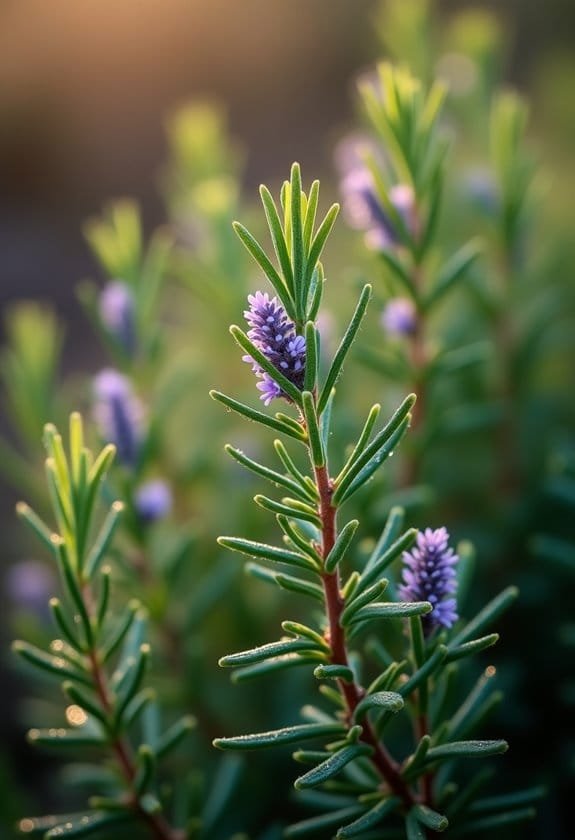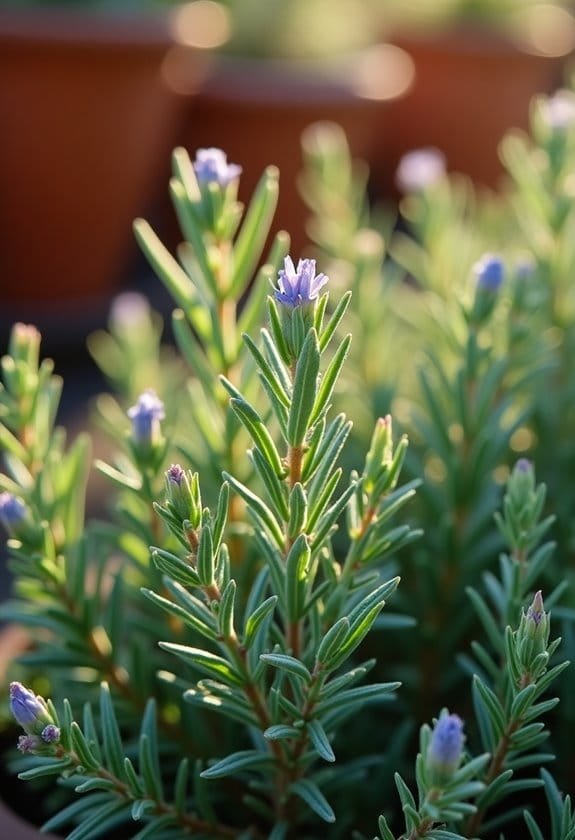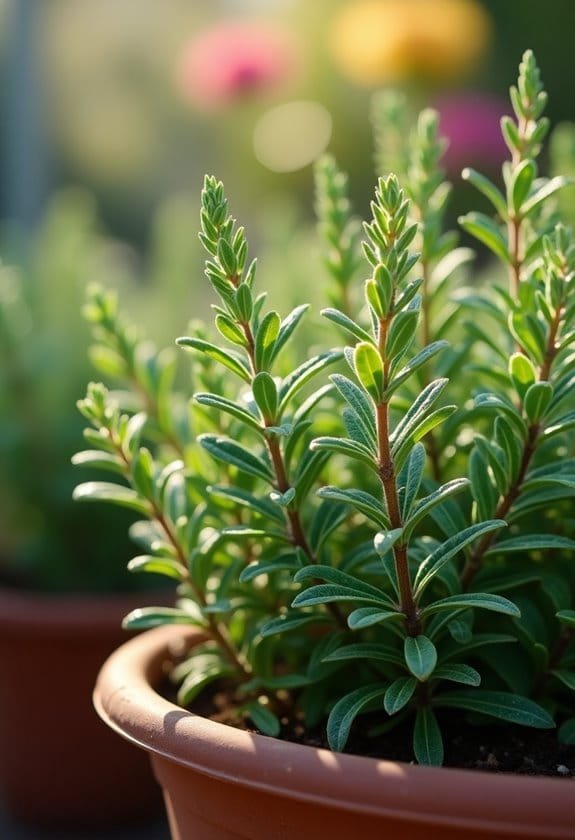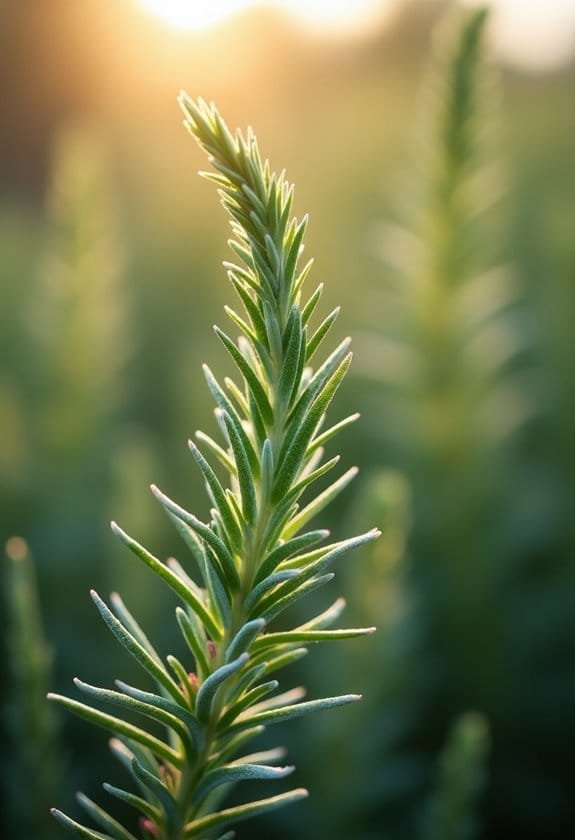Rosmarinus officinalis, or rosemary, is an evergreen herb renowned for its culinary versatility and rich history, thriving in Mediterranean environments. This fragrant shrub, typically reaching 4 to 6 feet tall, showcases needle-like leaves and vibrant, tubular flowers that attract beneficial pollinators. Ideal for planting in well-drained, sandy soils, rosemary requires at least six hours of sunlight daily and deep, infrequent watering to thrive, as it's drought-tolerant once established. It also offers medicinal properties, possessing anti-inflammatory and antioxidant effects. Proper care, including regular pruning and pest management, guarantees its robust growth, promising even greater discoveries ahead.
Main Points
- Rosmarinus officinalis, or rosemary, is an evergreen shrub known for its flavorful leaves used in Mediterranean cuisine.
- It thrives in sunny, well-drained sandy soils with a slightly acidic to neutral pH.
- Rosemary exhibits medicinal properties, including anti-inflammatory and antioxidant effects, and benefits digestive and respiratory health.
- The plant attracts beneficial pollinators like bees and butterflies, enhancing local biodiversity.
- Common issues include root rot and pests, but proper care and monitoring can prevent most problems.
Introduction

Rosemary, scientifically designated as Rosmarinus officinalis, is a remarkable evergreen shrub celebrated for its aromatic qualities and versatile applications.
This herb thrives in the Mediterranean's rugged terrain, favoring sandy soils and abundant sunlight, while its historical significance as a symbol of remembrance and fidelity enhances its cultural importance.
Understanding rosemary's characteristics not only opens a door to its culinary and medicinal uses but also highlights its ecological benefits, making it a valuable addition to any garden.
Common Name
Originating from the Latin for "dew" and "sea," the common name rosemary evokes its natural habitat along Mediterranean coastlines. The herb, scientifically known as Rosmarinus officinalis, stands out prominently within the domain of culinary uses, especially in Mediterranean cuisine. Known for its robust aroma and distinctive flavor, rosemary enhances a variety of dishes, including succulent meats, hearty breads, and vibrant vegetables.
Beyond its culinary applications, the term "rosemary" also resonates culturally, symbolizing remembrance and fidelity. This association is particularly significant in literature, where it frequently appears in poetic references, and at weddings, serving as a poignant reminder of enduring love.
Notably, while its scientific classification has shifted over time—now often referred to as Salvia rosmarinus—the common name rosemary persists in everyday language and practice, reflecting a deep-rooted connection to history and tradition.
Various regional names, like "sea dew" and "anthos," further highlight rosemary's longstanding ties to maritime culture, indicating its broad impact across different contexts. Consequently, rosemary remains an essential and cherished member of both culinary and cultural landscapes, bridging its historical significance with contemporary usage.
Scientific Name
The scientific classification of rosemary reflects its rich botanical heritage and connections within the Lamiaceae family. This aromatic perennial shrub, traditionally known as Rosmarinus officinalis, has recently been reclassified as Salvia rosmarinus, emphasizing its relationship with the sage family.
The name "rosmarinus" derives from Latin, translating to "dew of the sea," an apt descriptor for this resilient plant thriving in the Mediterranean's coastal regions, especially in Portugal and northwestern Spain.
Rosemary typically reaches heights of 4 to 6 feet, showcasing needle-like leaves that release a fragrant aroma when touched. These leaves, imbued with essential phytochemicals such as rosmarinic acid and camphor, contribute to the herb's numerous culinary and medicinal applications.
The shift to Salvia rosmarinus underscores the evolving understanding of rosemary's taxonomy and biological significance. Through its classification, one can appreciate not just its ecological role but also the culinary delights it enhances, bridging the gap between nature's bounty and the human palate.
In a world increasingly attuned to the nuances of plant use, rosemary stands out, symbolizing the enduring bond between humanity and the rich offerings of the earth.
Overview
Known for its distinctive aroma and vibrant appearance, rosemary captivates both gardeners and culinary enthusiasts alike. Scientifically recognized as Rosmarinus officinalis, this aromatic evergreen shrub thrives in the warm, sun-drenched regions of the Mediterranean, where it flourishes in sandy, well-drained soils.
Rosemary's needle-like leaves and delicate pale blue flowers not only enhance garden aesthetics but also serve practical purposes, as they attract beneficial pollinators like bees and butterflies.
Rosemary is widely celebrated for its culinary uses, enriching the flavors of meats and vegetables. It possesses a robust flavor profile that can transform a simple dish into a gastronomic delight. Additionally, its medicinal properties, historically utilized in natural remedies, support digestive and respiratory health.
Symbolically, rosemary embodies themes of remembrance, fidelity, and friendship, often playing a role in cultural practices dating back to ancient Greece and Rome.
This multifaceted plant, combining beauty with functionality, is more than just a culinary herb; it embodies cultural significance and ecological benefits. Overall, rosemary stands as a manifestation of the intersection of nature's artistry and humans' culinary creativity, making it a beloved staple in gardens and kitchens worldwide.
Key Features
Rosemary, an evergreen shrub, typically reaches a height of 4 to 6 feet, showcasing its leathery, grayish-green needle-like leaves with a striking dark green upper surface.
It blooms in spring and summer, producing clusters of small, delicate flowers in pale blue, pink, or white, adding to its visual appeal.
As it flourishes in full sun and well-drained soils, this resilient plant not only enhances gardens but also enriches culinary experiences with its aromatic qualities.
Growth Size
Growing up to 4 to 6 feet tall, rosemary forms a dense, bushy shrub with a spread of 3 to 4 feet that can gracefully enhance any garden.
This perennial plant thrives best in full sun, as it requires at least six hours of direct sunlight daily to achieve its ideal growth size and health. Without adequate sunlight, the shrub may struggle to reach its full potential, resulting in weaker, less aromatic foliage.
Rosmarinus officinalis is remarkably hardy, tolerating temperatures as low as 20°F (-6°C), which contributes to its appeal for various climates.
This resilience, combined with its preference for well-drained soils, makes rosemary suitable for dry, rocky terrains often found in the Mediterranean region.
The plant's adaptability allows it to flourish even in less-than-ideal conditions, provided it has the right environment.
Appearance
This aromatic evergreen shrub showcases enchanting features that enhance its appeal in any garden setting. Rosmarinus officinalis typically reaches a height of 4 to 6 feet (1.2 to 1.8 meters), presenting a formidable presence among other plants.
One of its most distinctive characteristics lies in its needle-like leaves; these leathery, dark green leaves possess a grayish-green hue on their upper surfaces while revealing a whitish underside. This color contrast adds visual interest and texture to the foliage.
In addition to its striking leaves, rosemary produces small flowers that bloom in clusters along the branches during warmer months, typically offering shades of pale blue, pink, or white. These flowers not only contribute to the plant's ornamental value but also attract various pollinators, enhancing biodiversity in the garden.
The stems of this evergreen shrub are square and straight, ranging from brown to green, exuding a potent aromatic scent when brushed. This remarkable aromatic quality adds to the plant's allure, making rosemary a popular choice for culinary delights and garden aesthetics alike, ensuring it remains a cherished fixture throughout the seasons.
Flowering Season
During the vibrant months of spring to summer, rosemary bursts into a spectacular display of color, with its flowering season peaking from April to June. During this time, the plant produces small, tubular flowers that range from pale blue to deep purple, and even white, creating a stunning contrast against its lush green foliage.
These flowers, each approximately one inch in size, grow in clusters along the branches, enhancing the overall aesthetic and aromatic qualities of the plant. Rosemary's blooming period plays an indispensable role in attracting beneficial pollinators like bees and butterflies, which contribute to the health of the surrounding garden ecosystem.
The presence of these vibrant flowers not only signifies the plant's vigor but also indicates proper care; well-maintained rosemary often yields a more abundant and eye-catching display of blooms. Additionally, the flowers' fragrant nature enhances the sensory experience of the garden, inviting both human admirers and essential pollinators alike.
Consequently, the flowering season of rosemary serves as a significant time, intertwining beauty, ecology, and care, making it an integral aspect of this beloved herb.
Growing Requirements

Rosemary thrives best under specific growing conditions, highlighting its preferences for light, soil, water, and temperature.
This aromatic herb requires at least six hours of direct sunlight daily, favoring sandy, well-drained soils with a slightly acidic to neutral pH.
Additionally, while it's drought-tolerant once established, it demands deep, infrequent watering to prevent root rot and requires careful attention in cooler climates, where it can face challenges despite its robustness.
Light
For healthy growth, rosemary plants need full sun, requiring at least six hours of direct sunlight each day. This exposure is crucial for peak growth, as it enhances the flavor profile of the aromatic leaves and supports bushy growth, ultimately leading to delightful flowering.
Thriving in warm conditions, rosemary is ideally suited for hardiness zones 8 to 11, making it a perfect candidate for Mediterranean climates.
Furthermore, rosemary is relatively drought tolerant once established, which means it can withstand periods of dryness without compromising its health.
However, to maintain robust energy, gardeners must guarantee the plant resides in well-drained soils. Soil that retains excess moisture can lead to dire consequences, including root rot, which severely jeopardizes the plant's longevity.
Soil
Healthy rosemary growth relies heavily on appropriate soil conditions. This herb thrives in sandy, well-drained soils that prevent water retention, which is important since rosemary is particularly vulnerable to root rot. A slightly acidic pH, ideally ranging from 6.0 to 7.0, supports its best development. Poor drainage, often found in heavy clay soils, can lead to detrimental waterlogged conditions, stifling the plant's health and growth. Additionally, many plants, similar to rosemary, perform best in well-draining loamy soil, highlighting the importance of soil quality.
To cultivate rosemary successfully, gardeners should prioritize planting in spring or early fall, allowing the plant ample time to establish its root system before harsh weather sets in. Spacing plants 18 to 24 inches apart guarantees that each bush has access to necessary nutrients and sunlight, fostering robust growth.
Additionally, it's necessary to regulate watering habits. Overwatering is a common mistake, as excessive moisture leads to root rot, ultimately compromising the plant's liveliness. By allowing the soil to dry out between infrequent, deep waterings, the gardener reinforces the plant's drought resistance. Furthermore, rosemary is also known to benefit from planting alongside other durable plants like Sedum album which share similar soil and water needs.
Water
When it comes to watering, rosemary thrives on infrequent, deep irrigation rather than constant moisture. This herb exhibits remarkable drought-tolerant properties once established, making it an excellent choice for arid environments.
A critical aspect of growing rosemary involves encouraging good drainage; it prefers sandy, well-drained soils that prevent water accumulation. Overwatering can lead to detrimental conditions such as root rot and botrytis, which are potential threats to the plant's health.
To maintain ideal moisture, it's advisable to water the plant deeply about once a week. During this process, the soil should be allowed to dry out completely between watering sessions.
Regularly monitoring moisture levels is essential, as rosemary can thrive in conditions where the soil dries out adequately, reinforcing its resilience against drought. As a result, the watering routine should be adjusted according to the plant's needs, especially after it has become established.
Temperature
Rosemary flourishes in warm climates, thriving best in hardiness zones 8 to 11. The ideal temperature range for rosemary growth hovers between 60°F to 75°F (15°C to 24°C) during the day. Remarkably, this herb can withstand cooler temperatures at night, which can enhance its development, but a vital consideration remains its winter tolerance; temperatures should ideally remain above 20°F (-6°C).
Rosemary's affinity for full sun exposure is significant, as it requires at least six hours of direct sunlight daily to achieve peak growth and flavor.
Once established, this herb is remarkably drought-tolerant, thriving in warm, dry conditions while exhibiting sensitivity to overwatering, which can induce root rot. Therefore, gardeners must guarantee proper drainage in soils to maintain moisture balance.
In colder climates, vigilance is key; regular monitoring for significant temperature drops is imperative. In instances of harsh weather, protecting rosemary or relocating it indoors, especially if temperatures fall outside its hardiness range, might be necessary.
Such considerations guarantee that rosemary remains healthy and resilient, allowing it to flourish amid fluctuating environmental conditions.
Pollinator Criteria
Rosemary not only provides vibrant blooms but also serves as an important resource for various pollinators, particularly bees and butterflies.
These insects play an essential role in the pollination process, which involves transferring pollen from the male to the female parts of flowers, thereby facilitating the production of seeds and enhancing biodiversity. Additionally, rosemary is known to attract key pollinators such as bumblebees and butterflies, providing them with essential nectar.
Furthermore, by strategically grouping rosemary plants, gardeners can greatly increase visibility and accessibility for these indispensable creatures, promoting a thriving ecosystem in their gardens. Furthermore, like Common Yarrow, rosemary also attracts pollinators with abundant nectar, contributing to the overall health of the ecosystem.
Attracted Pollinators
Attracting an array of pollinators, rosemary (Salvia rosmarinus) plays an essential role in supporting local ecosystems. This aromatic herb particularly attracts bees, butterflies, and hummingbirds, providing significant benefits for pollinator populations and enhancing the overall biodiversity of gardens and surrounding environments.
During its flowering period in spring and summer, rosemary offers a consistent food source, as its vibrant blooms produce abundant nectar that's especially appealing to honeybees.
The strong aroma of rosemary, combined with its striking flowers, captivates various pollinators, creating a haven for these important species. As pollinators flock to rosemary, they help facilitate the reproduction of nearby plants, contributing to a thriving ecosystem that sustains multiple life forms.
Additionally, companion planting rosemary with other crops fosters favorable conditions for both pollinator populations and pest management, yielding a more sustainable garden environment.
Pollination Method
A variety of pollinators flock to the fragrant flowers of rosemary, primarily engaging in insect pollination. These beautiful blooms attract beneficial insects, such as bees and butterflies, with their aromatic scent.
Rosemary flowers are hermaphroditic, containing both male and female reproductive structures. This unique feature allows for self-pollination, although cross-pollination, facilitated by visiting insects, often leads to higher seed yields.
Blooming from spring to summer, rosemary produces clusters of small, pale blue to white flowers that enhance visibility, enticing numerous pollinators. The aggregation of flowers not only increases the likelihood of attracting these beneficial insects but also improves pollination efficiency.
To optimize growing conditions for rosemary, gardeners should consider planting these aromatic plants in groups and ensuring they receive adequate sunlight and nutrients.
Furthermore, the presence of rosemary in a garden contributes to local biodiversity, providing essential food sources and habitat support for a variety of pollinators.
Care & Maintenance

In nurturing rosemary, proper planting and ongoing care are essential for its vibrant growth.
This resilient herb flourishes under the sun's embrace, demanding a minimum of six hours of direct light daily while thriving in sandy, well-drained soils to safeguard its delicate roots from rot.
Additionally, selecting companion plants that share similar watering needs enhances both plant health and garden aesthetics, creating a harmonious ecosystem.
Planting Tips
Growing rosemary successfully hinges on a few essential care and maintenance practices. First, aspiring gardeners should focus on planting in areas that receive full sun, as rosemary thrives in hardiness zones 8-11 and requires at least six hours of direct sunlight daily for ideal growth.
Secondly, soil selection is important; rosemary flourishes in sandy, well-drained soils with a slightly acidic to neutral pH ranging from 6.0 to 7.0. Overwatering poses a significant threat, leading to root rot, while established plants demonstrate admirable drought tolerance.
When planting, spacing is key—gardeners should space rosemary plants 18 to 24 inches apart to promote air circulation, which helps maintain healthy growth and reduces disease risks.
The ideal planting times are in spring or early fall, allowing root systems to establish before extreme weather conditions arise.
Additionally, regular pruning not only encourages robust, bushy growth but also enhances the herb's flavor profile. Gardeners should refrain from harvesting more than one-third of the plant at a time, ensuring a continuous supply of fresh rosemary while promoting long-term health.
These planting tips lay the foundation for a thriving rosemary garden.
Ongoing Care
How can gardeners guarantee their rosemary maintains ideal health throughout its life? Ensuring rosemary thrives best involves a combination of strategic care and attention to its environmental needs.
This aromatic herb flourishes in sandy, well-drained soil types, typically requiring minimal watering once established, as overwatering can induce root rot, a common pitfall. Regularly evaluating the plant's exposure to sunlight is crucial; rosemary demands a minimum of six hours of direct sunlight to produce robust growth and develop its characteristic flavor.
To sustain its health, gardeners should prioritize good air circulation around the plant. This not only helps in preventing fungal diseases but also mitigates potential pest invasions. Monitoring humidity levels while maintaining proper drainage is essential for preventing these issues.
Light spring fertilization can further enhance flowering, ensuring the plant remains vigorous and lush. Additionally, engaging in regular pruning promotes bushy growth, encouraging a denser appearance and increased yield.
For propagation, using stem cuttings or division is preferable, as rosemary seeds typically have low germination rates. Through these practices, gardeners can foster a healthy rosemary plant that stands resilient against the challenges of its growing environment.
Suggested Companions
Companion planting with rosemary can greatly enhance garden productivity while naturally deterring pests. This aromatic herb serves as an effective companion plant for crops like cabbage, beans, and carrots, offering a protective barrier against pests such as cabbage loopers and carrot flies.
Additionally, rosemary thrives alongside other Mediterranean herbs, including thyme, oregano, and sage, which prefer similar growing conditions, particularly full sun and well-drained soil.
Integrating rosemary into vegetable gardens not only enhances growth but also improves flavor, thanks to its ability to attract beneficial pollinators that aid surrounding plants. However, gardeners must guarantee adequate spacing of 18 to 24 inches between plants. This distance promotes good air circulation while preventing overcrowding, which can lead to fungal diseases like powdery mildew.
Regular pruning of rosemary encourages bushy growth and further enhances air circulation, thereby reducing disease risk within the garden bed.
Common Issues
Rosemary faces several common issues that can impact its health and vigor. Pests like spider mites and mealybugs can cause leaf discoloration and wilting, while diseases such as powdery mildew thrive in humid environments, necessitating careful monitoring and management.
Pests/Diseases
While growing rosemary can be rewarding, it often comes with challenges like pest infestations and diseases. Common pests like spider mites pose a significant threat, causing discoloration and webbing on the leaves, which can stunt the plant's growth.
Mealybugs, resembling cottony masses, can also plague rosemary, leading to yellowing leaves and diminished vigor.
Equally concerning are various fungal diseases that afflict rosemary, particularly powdery mildew, which thrives in humid conditions. This ailment manifests as a white, powdery coating, obscuring the leaves and impacting photosynthesis.
Such conditions can flourish particularly when air circulation is poor, underscoring the importance of proper plant placement.
Root rot, a critical issue often caused by overwatering or inadequate drainage, can lead to significant plant decline or even death. The roots, deprived of oxygen, begin to decay, impairing the plant's ability to absorb essential nutrients.
Regular inspection of rosemary plants allows for early detection of these adverse conditions, which is paramount for maintaining health and vigor.
Solutions
To effectively tackle the common issues associated with rosemary, gardeners should focus on proactive strategies that promote plant health. Overwatering, a prevalent challenge, can lead to devastating root rot; therefore, it's vital to guarantee the soil is well-drained and to water infrequently but deeply once the plant matures.
Incorporating proper humidity control plays a significant role in preventing powdery mildew, as excessive moisture in the air can foster this issue. Establishing proper air circulation around rosemary plants can effectively mitigate such risks, much like how Alexanders thrives in well-draining conditions.
In terms of pest management, regular monitoring for spider mites and mealybugs can enhance plant vigor remarkably. Employing natural insect repellents will help deter these pests without harming the environment.
Additionally, pruning is essential for encouraging a bushy structure and managing growth effectively. Ideally, gardeners should prune in spring to avoid excessive loss of foliage all at once.
Furthermore, positioning rosemary plants at a distance of 18 to 24 inches apart guarantees adequate sunlight exposure and airflow, reducing competition for nutrients and minimizing disease risk.
To support the plant's growth, it is equally important to ensure it is planted in acidic, well-drained soil, as this aligns with its natural habitat for optimal health.
Through these meticulous strategies, gardeners can nurture robust rosemary plants that thrive beautifully in their landscapes.
Summary

Known scientifically as Rosmarinus officinalis, this aromatic evergreen shrub thrives in the warm, dry climate of the Mediterranean region. Renowned for its fragrant foliage and excellent adaptability, rosemary flourishes best in well-drained, sandy soil and requires full sun exposure for at least six hours daily. Its hardiness enables it to grow in Zones 8 to 11, exhibiting drought tolerance once established, though caution is necessary to avoid root rot from overwatering.
Beyond its culinary purposes in Mediterranean cuisine—where it enhances the flavors of meats, vegetables, and breads—rosemary carries significant historical and cultural weight. Symbolizing remembrance, fidelity, and friendship, it has featured prominently in weddings and funerals since ancient Greece and Rome.
Moreover, rosemary possesses potential health benefits attributed to its essential oil, which may aid in treating digestive issues and respiratory ailments while enhancing memory—all widely recognized in aromatherapy practices.
This multifaceted herb invites exploration, both for its uses in the kitchen and its role in traditional medicine, cementing its status as a cherished herb that merges culinary delights with rich historical significance.


